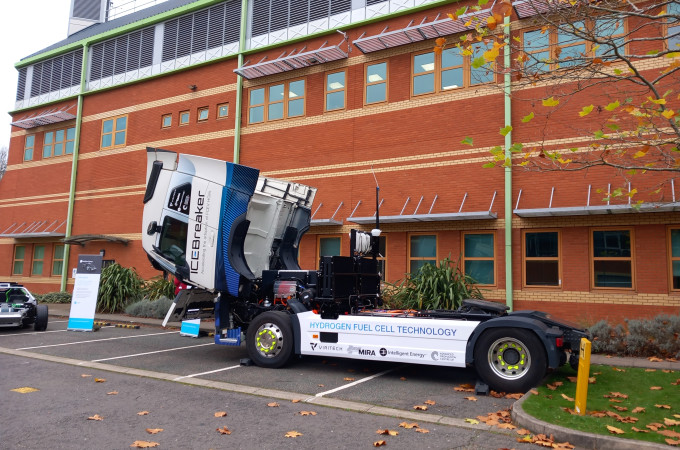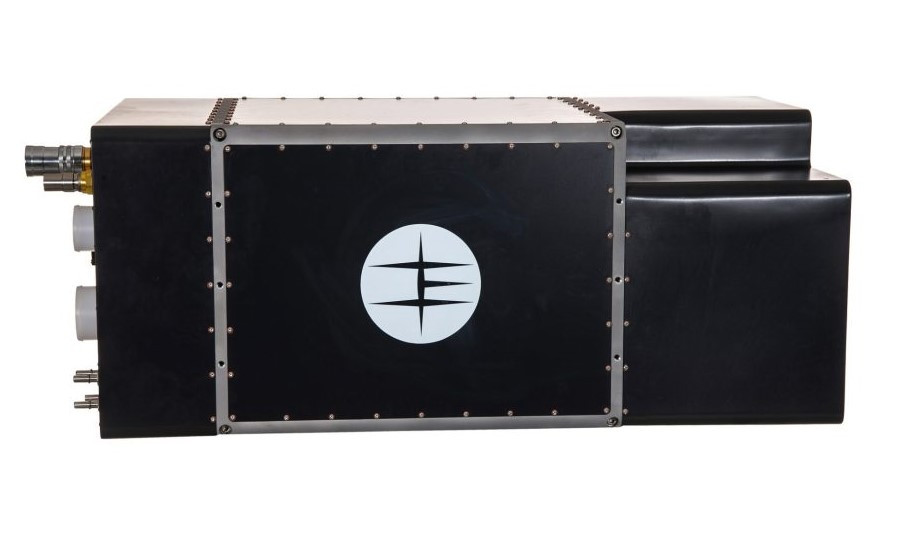From coal to hydrogen: T&BB report from Intelligent Energy’s open day in Loughborough
By Bradley Osborne - 18th February 2025

Project ICEBreaker truck outside Intelligent Energy's HQ in Loughborough, England
UK – On 30 September 2024, Britain’s last remaining coal-fired power station at Ratcliffe-on-Soar was closed down. Opened in 1968, the power station had a capacity of 2,000 MW and annual carbon emissions in the millions of tonnes when it was decommissioned. Though the reaction of the mainstream press to the end of 140 years of coal power in Britain was celebratory, the hulking remains of the power station and its eight cooling towers suggest other interpretations. The region where they stand was once called “Megawatt Valley”: along the shores of the River Trent, flowing from Staffordshire in the west to the Humber estuary on the east coast of England, a total of thirteen coal-fired power stations were active until decommissioning began in the 1980s. Today, local authorities and consortia have new ambitions for the old plants: to repurpose the existing infrastructure for the production of green hydrogen.
That was the message carried away by news reporters who attended an open day at the Loughborough University campus on 8 November. As yet, no final decision has been made about the redevelopment of nearby Ratcliffe-on-Soar, but visitors on that day did get to see some mature products of the transition taking place in the east midlands. These were the fuel-cell-powered vehicles displayed by Intelligent Energy Ltd in front of its headquarters on the edge of the campus, including an unmanned aerial vehicle and a tractor unit which will be known to readers of Truck & Bus Builder as the “Project ICEBreaker” truck.1
Having worked on fuel cell technology for several decades, Intelligent Energy is now ready to mass produce and commercialise its intellectual property for a diverse range of applications, including: drones, stationary power, material handling equipment, cars, commercial vehicles, trains, ships, and large aircraft. By virtue of its location in the heart of the midlands, Intelligent Energy hopes to be a prime mover in the region’s ambition to become a so-called “hydrogen valley”, or a hub of renewable energy production. Like one of its fuel cell drones, the company is sat waiting for lift-off.
Several things need to change before that can happen. T&BB spoke briefly with Greg Harris, Intelligent Energy’s Chief Commercial Officer, during the open day. He said that there are three obstacles to the maturation of a hydrogen economy in the region. The first is the cost of the hydrogen itself, particularly hydrogen which is produced renewably (i.e., “green” hydrogen). The second is the lack of infrastructure for producing and transporting green hydrogen at scale; the east midlands need facilities for making and moving the fuel to the end customers who are driving fuel cell electric vehicles. The third is the capital expenditure required to produce expensive fuel cell systems and their associated components. These are problems of volume: costs will come down once there is capacity to serve large numbers of end users.
1 This was first shown at last year’s Cenex in Millbrook; see https://truckandbusbuilder.com/article/2024/09/20/project-icebreaker-prototype-h2-fuel-cell-truck-on-display-at-cenex-2024
Background to Intelligent Energy
Researchers at Loughborough University began working on fuel cells with proton-exchange membranes in 1988. They successfully produced their first kilowatt-level fuel cell system in 1995, and a company called “Advanced Power Sources Ltd” was founded to commercialise the technology. In 2001, Intelligent Energy was born, another university spinout which acquired the former company and launched work on a range of different projects. In the 2000s, Intelligent Energy worked particularly with Suzuki on fuel-cell-powered motorbikes. Harris told T&BB that the technology came far ahead of the commercial applications. During these early years, when Intelligent Energy licensed its intellectual property to Suzuki and various German OEMs, the company’s engineers and researchers were exploring various avenues and discovering how its fuel cells could fit into each application.
A watershed moment in the history of the company came in late 2017, when Intelligent Energy was acquired by one of its shareholders, the investment firm Meditor Group. With capital from Meditor, Intelligent Energy’s focus for the last seven years has gradually shifted from research and development to mass production. Today, the company is based in a 5,500-square-metre site in Loughborough, with offices, labs, and a production line across individual workstations which has a capacity in excess of 6,000 units per year. The ninety test rigs in the labs can test up to a total power of 1MW. Intelligent Energy opened another test site in nearby Chelveston, expanding its testing capacity by an additional 1.3MW, though this location will be geared primarily towards fuel cells for aircraft.
Around 180 employees are based in Loughborough. Intelligent Energy employs people in Cupertino, California and Tokyo, Japan to support sales in North America and East Asia while also providing some limited engineering support in Japan.

The IE-Drive HD100
Fuel cell products and applications
Intelligent Energy has developed a series of different fuel cell systems, with power outputs ranging from 800 watts to one megawatt. The only product range which concerns us, however, is the ‘IE-Drive’, with outputs between 100 and 300 kilowatts. The IE-Drive can be used not only in commercial vehicles but also in passenger cars, rail, marine, and stationary power. The ‘IE-Drive HD100’ is tailored to trucks and buses, providing up to 100kW of continuous power.
The fuel cell modules produced by Intelligent Energy are surprisingly small: those on the lower end of the power scale can be held in one hand. Even the module designed for trucks and buses is fairly compact, weighing 285 kg (excluding the condenser) and packing the fuel cell stack and most of the balance of plant in a box measuring 1,260x520x700mm. Intelligent Energy also supplies the heat exchanger and exhaust system to its customers, reducing the time and effort required for installation.
Inside the IE-Drive HD100 are 432 fuel cells, assembled together in a stack. Safety tests are carried out in the company’s labs, and the fuel cells are managed while in operation with software developed in-house. Unlike the smaller units developed by Intelligent Energy which are cooled by the air, the IE-Drive HD100 has a closed-loop system which cools the fuel cells through the evaporation of water.
The company developed its first 100-kW fuel cell system in 2015. Since then, it has trialled the technology in multiple automotive applications. For buses, Intelligent Energy supplied fuel cell systems to a Taiwanese bus builder called Tsai Ying Clean Energy Co Ltd, starting in late 2023. For trucks, the company joined a project supported by the Advanced Propulsion Centre called ‘ICEBreaker’.
The brief of this GBP2.9m project was to develop a fuel cell electric powertrain suitable for a 44-tonne gross vehicle. The powertrain, developed by engineering consultancy Viritech, makes the fuel cell into the primary energy source, supported by a fast discharge/recharge battery pack. In a range-extended truck, the hydrogen fuel cells support a conventional electric powertrain, which still needs to carry several heavy battery packs. With Viritech’s design, the project claims that battery weight could be reduced by as much as 80%.
A proof-of-concept truck has been built as a result the project, and this was displayed at the technology open day in November. It is powered by a 110-kW fuel cell system made by Intelligent Energy, providing all of the continuous power the truck needs to run. Now that the project is concluded, the ICEBreaker truck, installed with Intelligent Energy fuel cells, is available to OEMs and operators for testing.



